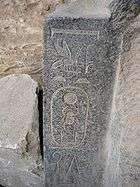Sky (hieroglyph)
The ancient Egyptian Sky hieroglyph, (also translated as heaven in some texts, or iconography), is Gardiner sign listed no. N1, within the Gardiner signs for sky, earth, and water.
| Sky (heaven) in hieroglyphs |
|---|

| Wikimedia Commons has media related to Category:Sky (pt hieroglyph). |
The Sky hieroglyph is used like an Egyptian language biliteral-(but is not listed there) and an ideogram in pt, "sky"; it is a determinative in other synonyms of sky. For the language value hrt, it has the phonetic value hry.[1]
Pt, with Gods and the Pharaoh
The Sky hieroglyph can be found in iconography with the gods, especially Ra as referencing the Lord of P(e)t, (Lord of Heaven), and the God's ownership of Pet. The Pharaoh is often equally named as the Lord of Pet.
Some ancient Egyptian names using the sky hieroglyph are Petosiris and the god Petbe.
Ligatured variants of Sky
The simple 'vault' of the sky hieroglyph has variants that are ligatured with it. Three of these are given separate entries in Gardiner's sign list:[2]
Why the sky hieroglyph is not a biliteral
Though the sky hieroglyph is used as pt, in the Coptic alphabet, for the Coptic language, (the follow-on to the Egyptian hieroglyphs), the spelling of the "sky" is "pe" in Coptic. Consequently, Budge's 2-volume dictionary lists the sky hieroglyph under "pe-t"[3]
| Preceded by Stool-or-mat (hieroglyph) unileral-P (start of P's) |
sky-("heaven") "pt" |
Succeeded by Bird in flight p3-(pa) |
- Relief

- Temple of Hatshepsut
 Hieroglyph-(using Sky hieroglyph)
Hieroglyph-(using Sky hieroglyph)
See also
- Gardiner's Sign List#N. Sky, Earth, Water
- List of Egyptian hieroglyphs
- Nut (goddess)
References
| Wikimedia Commons has media related to Category:Sky (pt hieroglyph). |
- Betrò, 1995. Hieroglyphics: The Writings of Ancient Egypt, section: Sky, p. 150.
- Betrò, 1995. Sky, p. 150.
- Budge, 1978, (1920). An Egyptian Hieroglyphic Dictionary, entry pe-t, p. 229A.
- Betrò, 1995. Hieroglyphics: The Writings of Ancient Egypt, Maria Carmela Betrò, c. 1995, 1996-(English), Abbeville Press Publishers, New York, London, Paris (hardcover, ISBN 0-7892-0232-8)
- Budge. An Egyptian Hieroglyphic Dictionary, E.A.Wallace Budge, (Dover Publications), c 1978, (c 1920), Dover edition, 1978. (In two volumes) (softcover, ISBN 0-486-23615-3)